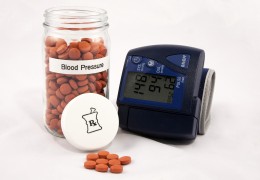Hypertension Guidelines for Children and Teens
 Your child has been diagnosed with high blood pressure. You know you need to do something, but you’re not quite sure where to begin. In the prior article, we discussed how high blood pressure left untreated, puts your child at serious risk for dangerous health problems. So, what’s next? Do you start your child on a pharmaceutical drug or are there natural high blood pressure remedies you can employ?
Your child has been diagnosed with high blood pressure. You know you need to do something, but you’re not quite sure where to begin. In the prior article, we discussed how high blood pressure left untreated, puts your child at serious risk for dangerous health problems. So, what’s next? Do you start your child on a pharmaceutical drug or are there natural high blood pressure remedies you can employ?
First, you need to know what you’re dealing with. If your child has high blood pressure due to uncontrolled factors (a genetic heart defect, etc.), then you will likely need to seek the advice of a physician who can determine if lifestyle factors alone can help your child or if medications are also needed. In some cases, an integrative physician may be able to recommend certain supplements to help your child. On the other hand, if you are dealing with hypertension caused by controlled factors, lifestyle changes alone may work wonders!
Essential Hypertension Risk Factors
When a child is diagnosed with high blood pressure due to controlled factors – that is, without any underlying medical condition – this is termed, “Essential Hypertension”. Essential hypertension occurs more often in older children and adolescents. The risk factors for developing essential hypertension are:
- Being overweight or obese (a body mass index over 25)
- Type 2 diabetes, also called “adult-onset” diabetes
- High cholesterol and triglycerides
The high blood pressure remedies for each these risk factors involves some straight forward lifestyle changes. For example, if your child’s high blood pressure is caused by obesity, losing weight can eliminate the need for medication.
High Blood Pressure Medications
If you decide that lifestyle changes will be too difficult for your child, there are a few things you need to know. First, little is known about the long-term effects of blood pressure medication on a child’s growth and development. Second, depending on the specific drug, side effects are possible (listed below). Third, once you start your child on a blood pressure medication, he/she may need it indefinitely – for the rest of their life – if contributing lifestyle factors are not addressed.
It is important to note that a child who has an extremely high blood pressure level may need medication immediately, but you can simultaneously implement lifestyle changes. Talk to your child’s doctor to see if medication is necessary initially or if it can wait to try lifestyle changes first.
The most commonly-prescribed blood pressure medications include:
- Diuretics – act on the kidneys to help remove sodium and water.
- Beta blockers – reduce the workload on the heart by causing it to beat slower and with less force.
- Angiotensin I-converting enzyme (ACE) inhibitors and angiotensin II receptor blockers – help relax blood vessels by blocking the formation of enzymes that narrows blood vessels.
- Calcium channel blockers – help relax the lining of the blood vessels and slow heart rate.
BP Medication Side Effects
Medications used to manage blood pressure may cause a variety of side effects. According to the Mayo Clinic, the following side effects are most common:
- Digestive effects such as nausea, vomiting, constipation, diarrhea or loss of taste
- Mood changes such as depression, anxiety, irritability and agitation
- Persistent dry coughing
- Peripheral edema (swelling of the hands or feet)
- Sleep problems such as insomnia
- Muscle weakness, leg cramps and/or fatigue
- Frequent headaches
- Heart palpitations
- Increased blood sugar levels
- Too much of a drop in blood pressure causing low blood pressure symptoms such as dizziness, orthostatic hypotension (decrease in blood pressure when standing up) or even shock[1]
***Never stop or change medications without consulting with your child’s physician.
High Blood Pressure Remedies for Children and Teens
The number one way to either prevent high blood pressure or normalize high blood pressure levels in children with essential hypertension is to adopt healthy lifestyle changes. To learn about these important strategies you can begin implementing TODAY to protect your child’s health, click here.
[1] Mayo Clinic.
This post originally appeared in 2012 and has been updated.


 Ask the EN Experts March 2025
Ask the EN Experts March 2025  Vegan Diet Better Than Omnivore Diet for Cardiovascular Health
Vegan Diet Better Than Omnivore Diet for Cardiovascular Health 